INBOUND 2020 has come and gone, and this year’s virtual experience offered all of the same awesome programming this conference is known for and more. I joined Portent’s client partner team for two days of education sessions, deep dives, HubSpot best practices, and live debates on all things related to inbound marketing.
With all of the quality content we learned, it was hard to narrow down our favorites! Below are the top takeaways from INBOUND 2020 that Kyle Eliason, Kirsten Pickworth, Ann Robison, Matthew Taufa’asau, and I wanted to share.
Everybody Is Your Customer: How Ditching the Acquisition Funnel Supercharged Growth
Presented by: Julie Zhou, Sr Director of Growth AdRoll, a Division of NextRoll, Inc.
Many companies, and frankly, many of our new clients still focus on creating content about their business and deprioritize or never create the resources people actually want to read. Julie Zhou encouraged us to look beyond the acquisition funnel and decision journey focus stages when striving for growth and engagement.
AdRoll’s pivot to content marketing strengthened their customer relationships, brand awareness, and the collaboration between their sales and marketing teams. There were many moments during this session when I wished my clients were sitting beside me hearing recommendations I’ve shared before, but with the data-backed analysis and impact from Zhou.
Evaluate Relationships With Your Customers
Your company might be approaching a plateau or worse if you have low or neutral Net Promoter customer feedback scores or even unresponsiveness to your surveys. The lack of feedback or inconsistency in trends might be a greater risk than poor feedback because it alludes to no relationship or purely transactional communication with your target audience.
If you want to sustain the growth of your company and cross-selling products and solutions, strong relationships with existing customers are foundational. From those authentic relationships come product feedback, engagement, and even referrals. Rebuilding these relationships requires a change in perspective by both sales and marketing teams.
Treat Everyone Like They Are Already a Customer
This is how to get sales and marketing teams to renew their awareness of customer needs and slow the race of turning leads into money-spending customers. It sounds counter-intuitive, but taking a step back from lead scoring and transactional interactions can free up team members to build relationships with companies who might be high-value customers down the road.
Zhou argues that the funnel treats customers as a destination, and between sales and marketing, many potential customers are left behind inadvertently. However, when using a flywheel framework, you recognize that you are not in control of the customer journey: customers are at the center of everything you do, customers join on their schedule, and it’s your job to engage them. She said you shouldn’t invest any less in someone because they are not giving you money yet.
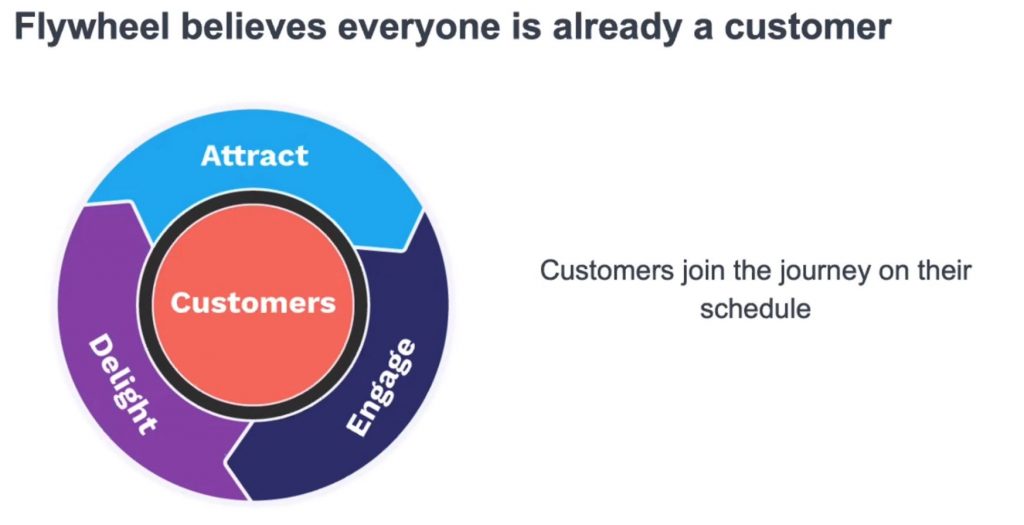
Invest in Content That Isn’t About You
Maintaining customer testimonials and product information is important, but your marketing content should be fueled by what your customer wants to learn. And especially in 2020 and through the pandemic, many potential customers need information and help, and they will remember the companies who provided it.
Continue with webinars and testimonials, but if you really want to acquire new customers, focus on exciting topics that they might consume at work or at home. And consider varying digestible content formats beyond your blog like infographics, podcasts, quick guides, or short explainer videos.
Even if you have a small marketing team, you can outsource content development to experts in your own company and your customer network and deepen relationships and brand awareness. AdRoll used this approach to increase their content production by 10X over two quarters. As a result, they saw the number of new blog visitors increase 300%, organic search traffic increase 50% month-over-month, and spend potential increase 100%.
And more importantly, the sales team started rebuilding relationships with current and potential customers by sharing helpful resources about industry trends, not products and features. That pivot led to more engagement and brand visibility.
The End of Technical SEO: How Google’s AI Forces SEO Strategies to Be More Human
Presented by: Dale Bertrand, President, Fire&Spark
“How do we get more non-branded organic traffic?” This session, led by Dale Bertrand, a search marketing and AI expert, answered this question I hear from many clients. He provided a simplified explanation of how the Google algorithm is evolving to better answer user queries and a model for how to gain visibility with a human-centered approach to SEO.
Our goal as marketers is to accelerate sales, site traffic, and organic leads. Bertrand argues that we should keep this goal in mind, but pause to consider the context of search queries and have empathy for potential customers. Why? Because Google’s AI-based search engine is using both of those factors when determining which result to rank first.
Many SEO consultants spend a significant amount of time on technical audits, guest posting, and optimizing H1 tags to improve search visibility. Although determining if technical concerns exist or are risks is valuable, technical SEO alone will not dramatically affect rankings.
Your SEO Strategy Should Involve Content AND Technical
Sometimes we forget that Google is a marketing engine too and is working on its customer engagement daily by finding the best content to match each query and aiming to delight users using their search engine. AI is used when web crawling, parsing information, evaluating content quality, and training the search engine.
The challenge with the algorithm shift—from rules-based to AI-based—is that even if we know how the algorithm works, we might not know exactly why a specific ranking decision was made and why our content was outranked. What we do know is that AI is making the search engine rank content more like a human would, with empathy and context.
This means that websites need to be optimized for the people who will engage with them, not solely the bots that will crawl them. The tried and true technical methods won’t work as well as they used to and can’t stand on their own.
Your SEO Strategy Needs a Mission
Successful brands provide value for human communities and fill information gaps for Google. Bertrand recommends that B2B and B2C brands should have an SEO mission and focus on customer engagement to:
- Go beyond targeted keyword content
- Create content that connects with your audience
- Partner with like-minded individuals
- Outreach to promote your mission, not your content
- Do good in their industry and community
So what types of content are mission-driven and helpful to your audience, potential partners, and Google? Citable content like interviews, surveys, and proprietary data, even if collected informally, contains valuable information that people want to learn and share. When aligned with your brand mission, this evergreen content becomes a foundation for paid social, digital PR, and backlinks from other brands.
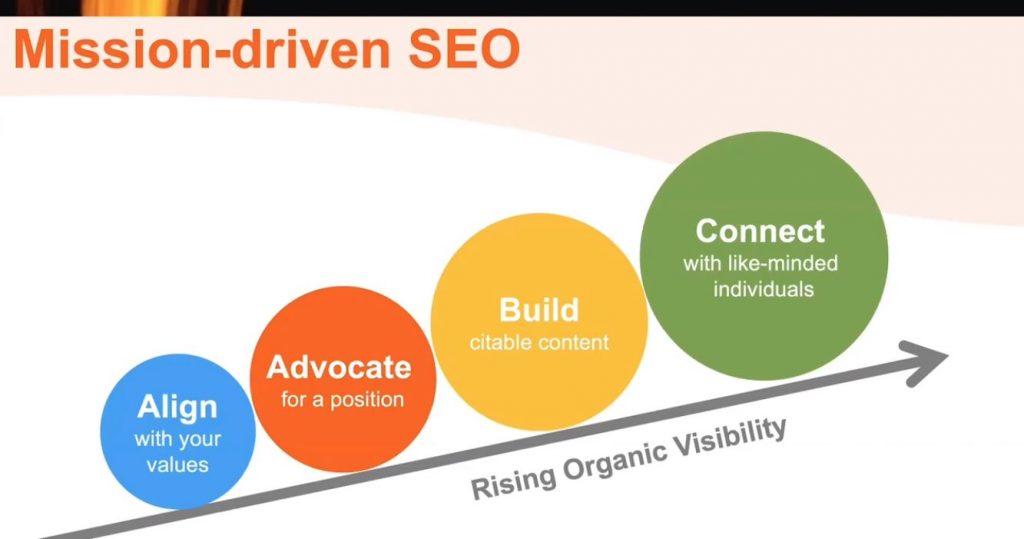
You Need a Human SEO Approach
Over-optimization around crawl budget and H1s is a waste of time when the KPI is organic visibility. At Bertrand’s agency, they check to see if anything is majorly wrong with the site and then quickly move on to content creation. He argued that most technical optimizations don’t move the needle on their own. The exception is large sites (>10,000 pages) and sites built on a custom CMS.
In 2020, more companies need to sell online, consumers are more sophisticated with their research and search queries before making a purchase, and Google’s AI is focusing more on search intent. As marketers, we need to adopt an approach that appeals to both customers and search engines: a human SEO approach. Bertrand provided this framework for how B2B or B2C business can become more human and mission-driven:
- Empathy: Conduct customer research and real-time keyword research in addition to using SEO tools. Understand what your potential customers need and how they are searching for it right now.
- Presentation: What is Google showing in the SERP? Understand the type of content you need to create – information, checklist, infographic, etc.
- Engagement: Ensure that your content is relevant to the queries users are clicking from. Review metrics like time on site and bounce rate together.
- Amplification: Build out organic visibility to support other channel conversion rates (i.e., social media, email, paid search, etc.) and continue the conversation around your mission.
- Purpose: Reflect on how this customer engagement confirms your mission and company values.
This method allows marketers, sales, SEO, and content teams to brainstorm around content creativity as a means for building search engine authority. Build more content that supports potential customers in the researching and deciding steps in the middle of the funnel and supports connection with your mission. Your audience and visibility will start to grow, and you can then develop partnerships that will help you generate more content.
We’ve known for a while that Google’s algorithm has shifted, and we can’t predict how results will always align with search intent. What we can do is shift away from the technical optimization game and proactively build relevant, well-researched content that answers user questions.
The Definitive Guide to Content That Sells: 7 Essential Steps to Massive Results and ROI
Presented by: Marcus Sheridan, President and Partner, Marcus Sheridan International
It’s pretty apparent why Marcus Sheridan is an Inbound Favorite. I’ll be honest; I hadn’t heard of him before attending his presentation. But I’m glad I tuned in to his talk; it was refreshing and offered a lot of helpful advice for marketers searching for the right content to create. To start, he leans into the idea that content must be a sales-first initiative. Your sales staff needs to answer hard questions that a savvy consumer will have. Marcus pressed his attendees to consider how much of their marketing material would a member of their sales team reference with a customer?
Marcus argues that marketers should seek to be the Wikipedia of their niche. Sure, you’re saying, we’re doing that. But are you really? There’s a lot of marketing out there that aims to be frank and honest but rarely hits the mark. Hiding vague answers behind flowery words will upset someone who took the time to read them. Instead, build your website to sell your products’ value and differentiators by answering the questions your sales team is already fielding.
A potential customer, he says, is likely looking to answer some or all of their “Big Five” questions.
Cost
Some marketers will dance around the subject, saying cost “depends on options or services purchased.” But that answer will undoubtedly irritate your potential customer who will seek this answer out elsewhere if they have to. So be a breath of fresh air and provide at least a pricing range. You’ll save potential customers hours of research.
Problems With a Product
People want to know what they’re in for when making a purchase. If your type of product has a few known issues, let people know about them. Be the resource that honestly answered the question, so someone else doesn’t do it for you.
Comparisons (vs. Other Products)
How do you stack up against the competition? It’s a hard question to answer, especially publicly. However, if you do it right, you get to craft a little slice of how you’re perceived.
“Best Of” Lists
If your business has data on the products that require the least amount of servicing post-sale, consider letting your customers know. Consider that this is a conversation that a trained salesperson is likely already having. It might be a value discussion where Brand A is pricier and more reliable compared to Brand B. If you are the only website answering this challenging question, you bring a ton of value.
Reviews
People are looking for reviews of you and your products. It takes work to get these done right, but your customers can tell if you can get honest review profiles set up. Do this both onsite and off.
Going down the path towards greater transparency will also require greater integration between sales and marketing. Marketing must continue to keep sales involved in their decisions. In fact, your sales team should definitely be a part of your content team. They are the SMEs and will ultimately answer questions on the phone or in the field right before making a sale. Sheridan argues that there shouldn’t be separate sales and marketing material. Instead, he suggests that honest and transparent content is the greatest sales tool.
Hacking the Marketing-to-Sales Handoff: Guarantee That Sales Takes Action on Your MQLs
Presented by: Charles Elmer, Director of Sales Enablement, Bayard Bradford
Alignment between sales and marketing. It seems like a straightforward concept. Yet, according to Charles Elmer, “Research we conducted in 2018-19 showed most companies were losing 15-35% of their impact because of inherent friction in their processes.”
During his presentation, he touches on the notion that sales and marketing are often disconnected. Further, he leans into the idea that sales are the glory hounds while marketing is left out in the cold. However, he mentions that marketing isn’t strictly ‘koozies and billboards.’ Marketing plays a huge part in building out pipelines and supplying leads. Using the tech available to us as marketers, we can better illustrate how we bring value to sales.
Elmer suggests one way to better show this value is to be more present in sales meetings. If we’re merely delivering automated leads to a sales team, we’re missing an opportunity to illustrate how we got them in the first place. Use a weekly sales and marketing meeting as an opportunity to exchange knowledge and to celebrate wins. Discuss new product features in these meetings, as both teams can benefit from telling customers about them. He says to set SLA for when both teams meet. He says to then be sure to set a time when the combined groups will present to leadership.
Maximizing Google Analytics Segments
Presented by: Karen Hopper, Senior Data Strategist, M+R
Google Analytics can be, frankly, intimidating. But the insights it provides into your audiences is valuable data that a business can’t afford to not access and understand. One of the most underutilized features of GA is its Custom Segments. The question Hopper dived into was, “How do I use Google Analytics Segments to provide actionable learnings?”
Segments can easily be used for the dark side (that is, “finding” evidence to support your theories and then not testing them to prove their validity), but it can also be used for good. Creating segments can help you focus on how to evaluate user behavior—rather than user characteristics—and can help illuminate patterns. It’s worth noting that segments are not personas. But they can help us build personas by looking at different behavior profiles.
Start as you would with any scientific experiment; that is, don’t pull out your Erlenmeyer flask and start pouring in chemicals. Your 10th-grade chemistry teacher would be ashamed. Before you begin, you need to identify what the question you’re trying to answer is. For example, “What is the demographic makeup of my audience that has an average order value over $100?” Once we have our question, we can dive into the data; Audience Demographics, Behavior Flow, Cohort Analysis. We need to find some data that can help answer our question.
Now we can form our hypothesis. Start by determining how you can identify users that you want to test. How can you tell people apart? Maybe, after digging into the data, you see that those high order value users are more likely to be on a desktop than a mobile device. Maybe you suspect that millennials have less disposable income, which is why the age range of the high average order value audience is 45+. These are all ways we can use segments through GA.
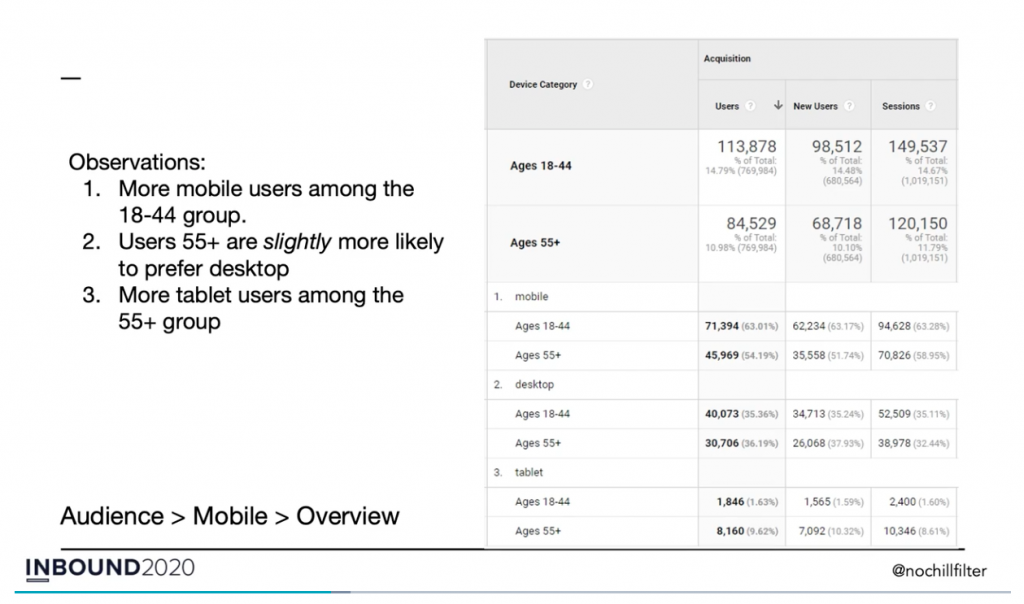
Next we can build our hypothesis into a test, again by channeling our inner 10th-grade chemistry class and filling in the blanks: changing A to B will impact X because Y. Perhaps our test is, “Changing our promotional sale banner to be more mobile-friendly, will impact the average order value for Millennials because Millennials are 80% more likely to view our website on their mobile devices.” Now that’s a test. And remember, a well-crafted hypothesis will always yield learnings, even if the test doesn’t end in the results we predict. It will also help you identify the test variables.
From Customer Service to Customer Experience
Presented by: Irina Rosenblit, Director of Customer Success, and Jonathan Corbin, VP of Success, Hubspot
Here’s a fun fact: 86% of buyers are willing to pay more for better customer experience. If this doesn’t pique your interest about the customer experience, we’re not sure what will. Irina and Jonathan delivered an eye-opening session with tons of great information. Here are three of the five key learnings they shared.
Define the Customer Journey
We can’t understand how to improve the customer experience if we don’t understand the customer’s needs. And the first step of understanding that is to plot out the customer journey. You need to know the key goals and actions that your customers take at every stage of the process and clarify who is responsible for what. Simplify the journey so that you can centralize accountability.
Establish Success Metrics
When it comes to progress, focus on meaningful, leading metrics, not lagging indicators, such as not renewing. Establish those success metrics early on, such as engaging in webinars, adding users, or completing surveys.
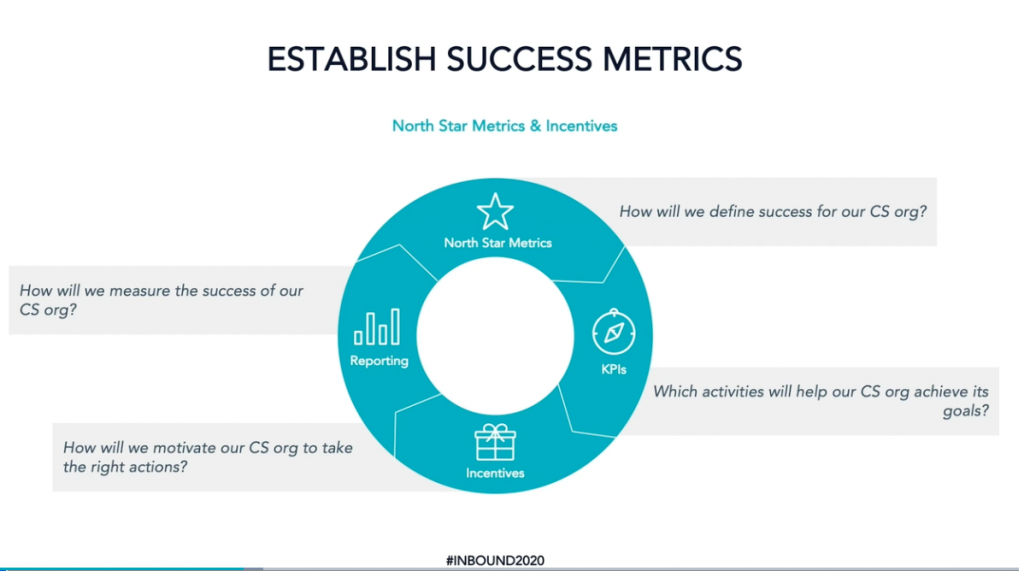
Invest in People
People are at the core of everything your business does and are your most valuable asset. Make sure your team has the knowledge they need. It’s critical that your employees can not only do the job they were hired for on a functional level, but that you allow them to continue to develop skill sets that they need to grow and evolve in their career through ongoing training in topics they’re passionate about.
Big Impact, Little Resources: How to Maximize Your Video Marketing Strategy
Creating a solid video marketing strategy for your business can seem daunting and costly. The truth is, creating effective marketing videos doesn’t have to be all that scary, and often marketers overestimate the effort that needs to go into it.
The first thing to know is that you can’t ignore video usage. If you’re avoiding using video content on your site, you’re at a huge disadvantage. Americans are consuming video content like never before, and it’s only trending up. They say people consume almost 6 hours a day while reading stays under 30 minutes.
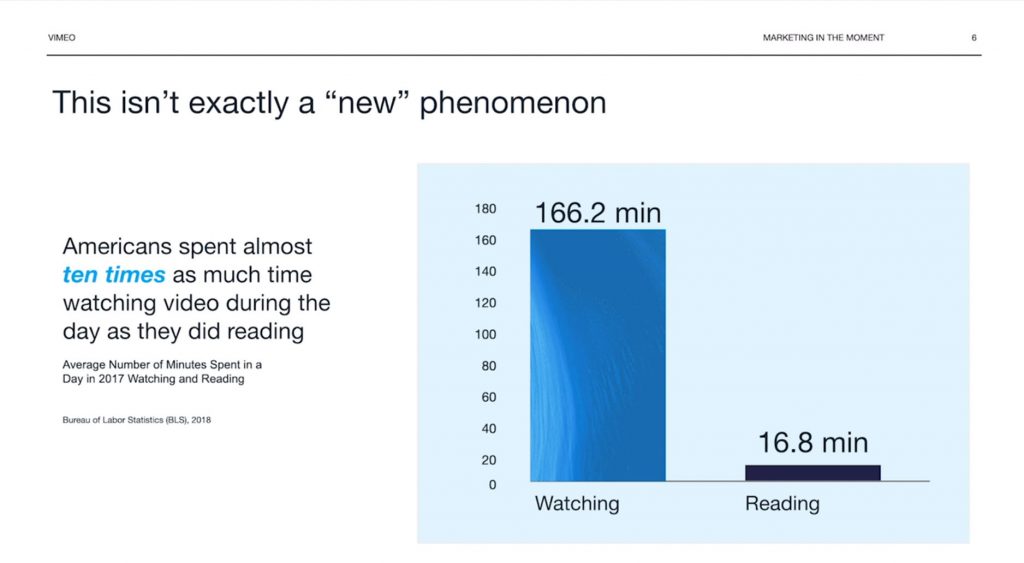
Some common myths keep marketers from producing video content:
- Myth #1: Video quality and format must be consistent across your channels. The truth is that both low and high production videos have a place, and both are important.
- Myth #2: Videos can just “go viral.” Although videos are more likely to go viral than text content, they need a solid distribution plan.
- Myth #3: Videos have high cost and no ROI. Videos can be extremely simple as long as they remain authentic. They can be super targeted for a single audience or goal and can engage your audience quickly.
- Myth #4: Video is just “capturing for posterity.” Videos can capture your audience extremely intensely; however, they tend not to be evergreen. They engage your audience in the moment.
There are many uses for video in a marketing strategy, like product videos, customer support, and testimonials. However, they can be used effectively for the unexpected like demonstrations, employee or executive profiles, and even user-generated content. Different flavors of content can coexist.
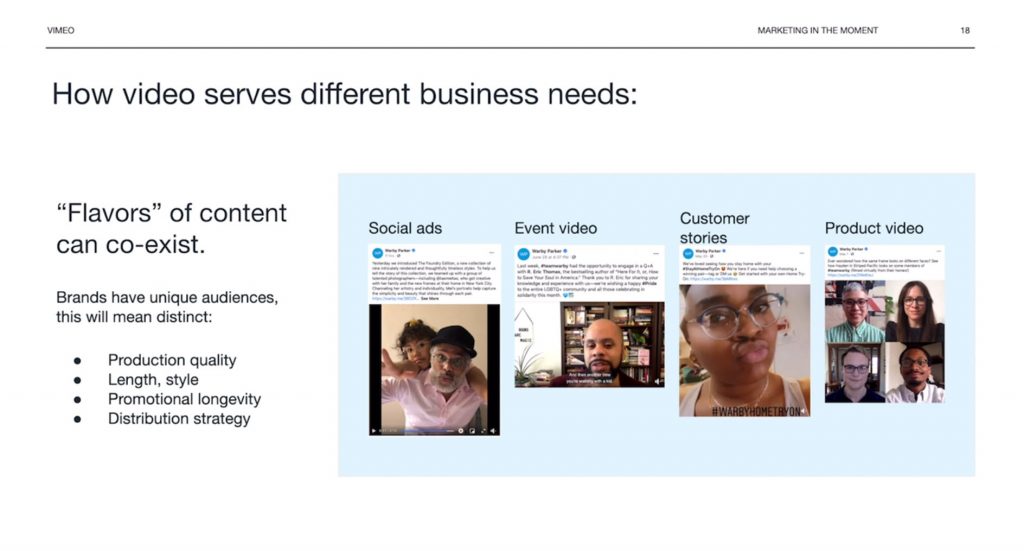
Creating and Delivering Compelling Presentations Online
Presented by: Richard Goring, Director, and Hannah Harper, Principal Consultant, BrightCarbon
With remote working at an all-time high, virtual presentations are the norm. The shifting landscape for remote communication will definitely be changed forever. So what are the challenges that we’re facing when it comes to our presentations?
Presentations are all about keeping the audience engaged. When they’re in person, you have the benefit of a live audience that can’t normally leave, doesn’t generally have multiple distractions, can participate in the presentation through questions, laughter, or applause, and the presenter has the benefit of being in the same field of view as the slides.
Online presentations, however, suffer from a tremendous amount of distractions and disadvantages. When a screen is being shared, your audience is forced to pay attention to the slide or the presenter’s face—not both. It’s almost impossible for the presenter to interact with the audience or read the room. Audience members are extremely distracted because they’re virtually hidden and have computers, phones, and other devices constantly in front of them. And then, of course, there are the technical issues like audience members forgetting to mute themselves.
So what do you do to make your presentations successful? You eliminate distractions and make your content more compelling.
Ways to eliminate distractions:
- Eliminate bandwidth issues. Test your connection speed and make sure, as the presenter, that you have at least a 2.5 Mbit upload speed.
- Use a room that isn’t too big or too small. Eliminate echo by having natural sound deadeners like furniture and curtains.
- Have a dedicated microphone instead of just using your native laptop microphone.
- Turn off your phone.
- Make sure that your audience is muted unless you specifically ask them for a question. Also, if you mute yourself, don’t forget to turn it back on before you talk.
- As the presenter, make sure you’re looking at the screen with your webcam and always try to be front-lit so you don’t hide in the shadows.
Ways to make your content more compelling:
- Use as many visuals as possible. Visuals communicate ideas much quicker, and your audience can listen to you while looking at images much better than if they’re trying to read.
- Use animation if you can. Try using morph transitions with Powerpoint for some slick animation. Also, there’s a really cool feature that allows you to use thumbnails for a table of contents and click through to different sections.
- Try turning off your webcam during the slide portion of the presentation. Only use your webcam for introductions or answering questions. Your face can be distracting. It will also help mask if you’re reading from notes or a script.
- Break up your content into small pieces from 5-8 minutes and then engage the audience with a poll or asking them questions. Alternatively, you can use a co-presenter for some quick banter.
10 Scientific Secrets That Make Your Content Impossible to Ignore
Presented by: Nancy Harhut, Chief Creative Officer, HBT Marketing
Nancy started her session by getting straight to the point: when people encounter marketing content, we aren’t always making rational, conscious decisions. We’re relying on automatic, instinctive responses that are hard-wired into our brains. These decision-making “shortcuts” can create quite the challenge for a marketer, whose goal is to create attention-getting, engaging content.
So as marketers, how do we circumvent these automatic responses to marketing, and deliver captivating content? According to Nancy, applying these 10 tactics will ensure content that cannot be ignored.
- Choose eye-magnet words. We may write in a linear fashion, but that’s not how people read. Attract the eye of the skimmer with words like “new,” “free,” “you,” and “sneak peek.”
- Use eye-catching images. Pictures were around long before the written word was. That’s why people prefer pictures to words, especially human faces that they can relate to.
- Leverage urgency and exclusivity. Create demand to create desire. Think limited time offers and private memberships. If something has limited availability or is exclusive, we want it more.
- Spark memories. Availability bias: people will determine the likelihood of needing something based on how easily they can recall a relevant example. Make your customers recall a time when they would have really benefited from your product or service.
- Help people draw their own conclusions. Tell a story, but let your customer relate it to them. And, believe it or not, if a phrase rhymes, it works even more!
- Let your customers speak for you. Trust is earned, and people will trust other people over a brand. Use social proof like testimonials and quotes.
- Make savings look big and prices look small. The same part of your brain that works when you stub your toe is activated when you have to spend money. Use copy that lessens the blow.
- Avoiding pain beats achieving gain. People are twice as motivated to avoid the pain of loss than to achieve the pleasure of gain. Tap into it with “don’t miss” CTAs and content that addresses “biggest mistakes and how to avoid them.”
- Create a ripple effect. Lead up to your goal conversions. Get your customer to say “yes” to something small (like following you on social media) and build on that. Once they agree to something once, more “yeses” are likely to follow.
- Bring in the experts. We are taught to respect and trust authority. Have experts promote your product or service. And, establish your own brand as an authority with things like checklists and “ultimate guides.”
B2B Trends for the Contrarian Marketer: Why to Bet Your Business on Trends That *Don’t* Change
Presented by: Ty Heath and Jon Lombardo, Global Leads for The B2B Institute @ LinkedIn
It’s true; most marketers are constantly wondering, “What is everyone else doing?” But according to Ty and Jon, the question we should be asking ourselves is, “What is nobody doing?”
Enter contrarian marketing. This approach focuses on ideas that oppose popular opinion, and likely go against current practice, but have been proven successful. And when you have a contrarian idea that has been proven right, you have a durable advantage. You can then build a business strategy around things that are stable in time.
Over the past five years, the B2B Institute has spent time identifying contrarian B2B marketing trends that make a difference. In this session, Ty and Jon shared the top three that they felt were the most durable and contrarian.
The War On Brand
There are two types of marketing: short-term (lead generation) and long-term (branding). We need both, and the key is finding the right balance between the two.
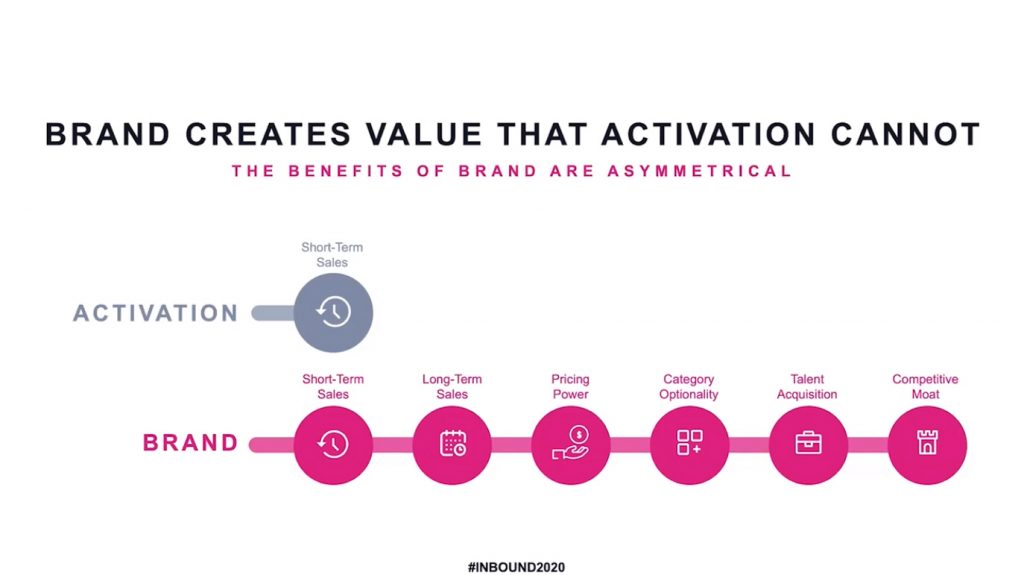
Short-term marketing increases sales, but the effects decay quickly. Building your brand creates value that new customer activation cannot. Brand marketing impacts long-term sales, pricing power, talent acquisition, and more. Ty cited one example of a B2B customer who ran an acquisition-only campaign that generated a 0.2% conversion rate. But when they combined sales activation and brand marketing, their conversions jumped 6Xm to 1.2%.
Approach your marketing strategy with both in mind; acquire new customers with short-term sales while simultaneously marketing your brand to impact future sales; target those out-of-market prospects so they eventually become in-market customers.
Blockbuster Marketing
If marketers want to monetize creativity, study the company that does it best: Disney, The Walt Disney Company has four creative principles we can apply to any content marketing strategy.
- Big Bets. Digital marketing focuses on a “test and learn” approach, but we’re usually testing a series of small, safe bets. Big bets are risky, but they can deliver big returns.
- Surprising Familiarity. Sequels and prequels make the most money. Old (good) ideas have a lot of equity built up in them. Capitalize on it!
- Consistent Distinctiveness. Look like yourself, and no one else. Make sure there’s consistency in the look and feel of your content.
- Total Merchandising. Take a single (again, good) idea, create different iterations, and use it across different channels.
The Death of Hyper Targeting
We’ve spent the last decade narrowly targeting tiny audiences. Ty and Jon maintain that we’ll spend the next decade broadly targeting big audiences. Account-based marketing is still relevant and will continue to work for businesses with a proven track record, a tight targeted market, and the resources to invest in ABM. However, in many cases, we’ve gone TOO hyper.
Instead, we need to focus on “relevant reach” for B2B. This allows us to capture both current and future buyers. Reach = growth. They made the case for broader targeting by identifying four common misconceptions.
- We have good data. But in reality, most third-party data is inaccurate.
- We have stable buying committees. But decision-makers change. Target the up-and-comers as well.
- We know the future. But really, optimizations beat predictions.
- Efficiencies. But the math rarely adds up.
Until Next Year
INBOUND 2020 has given us a ton of great information, tips and tricks, and insights on current and future digital marketing trends. We’re excited to apply what we’ve learned to what we do at Portent, and we’re already counting down to INBOUND 2021!









